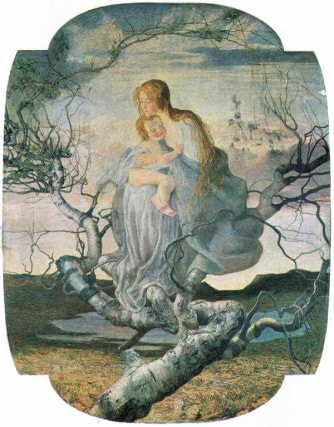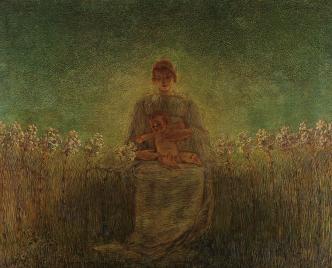 Christian Goddess, or the Angel of Life – Giovanni Segantini (1858-99) Segantini was not a church-going man, which makes Christian Goddess (1894) a strange title for one of his paintings. This canvas, however, was a commission from the Italian banker Leopoldo Albini to be hung in his extravagant home. The figures are supposed to represent the Virgin Mary and the child Jesus sitting in a barren tree. Some have interpreted this as being symbolic of both Jesus’ birth and death, the branches representing the crown of thorns. On the other hand, the branches may relate more to the mother than the child. The Virgin Mary has on occasion been nicknamed the “rose without thorns”, suggesting she has lived a sin-free life. The analogy developed from the idea that roses did not have thorns before the fall of Adam and Eve in the Garden of Eden. Despite the painting’s depiction of the relationship between mother and child, the figures were actually modelled on the artist’s nanny, Baba, and Segantini’s son, Gottardo. With this in mind, Christian Goddess, sometimes known as the Angel of Life, demonstrates the maternal instincts of women towards babies and young children regardless of their relationship.  Madonna of the Lilies – Gaetano Previati (1852-1920) Gaetano Previati was an Italian symbolist and contemporary of Segantini who also painted a representation of the Virgin Mary holding the Christ child. Unlike Segantini, Previati painted many artworks on a religious theme, particularly involving Catholic ideals. Madonna of the Lilies (1893-94), which originally had the shorter title Madonna, shows Mary in a seated position with the baby on her lap. This religious iconography has been around since the 15th century, although the Virgin is usually shown seated on a throne. Whilst Previati was influenced by tradition, he used the Divisionist style inspired by the Pre-Raphaelites. Divisionism involved separating colours into dots or dashes, although slightly subtler than Pointillism. The title Madonna of the Lilies has been used by other artists working on a similar theme. Although Previati’s painting contains the theme of motherhood, it’s Catholic connection is a stronger subject. Just as a thornless rose is used to describe the Virgin’s sinless lifestyle, lilies represent chastity and purity. To read the full article, click here This blog post was published with the permission of the author, Hazel Stainer. www.hazelstainer.wordpress.com
1 Comment
|
©Copyright
We are happy for you to use any material found here, however, please acknowledge the source: www.gantshillurc.co.uk AuthorRev'd Martin Wheadon Archives
June 2024
Categories
All
|
 RSS Feed
RSS Feed